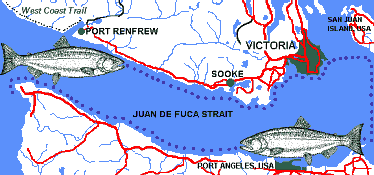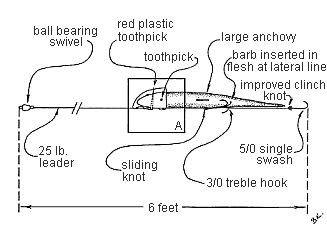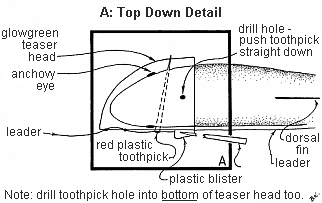
Columbian Connection:
Boating the Beauties of Juan de Fuca
-by
D.C. Reid
illustrations - Barb Krimmer

What better way to begin a new internet column than with a big splash. The Columbians are coming to Juan de Fuca and they're the biggest chinook salmon of the year. Averaging 40 pounds, and with the occasional fish over 60, they make for rod-snapping excitement in the late warm days of May, the month of June and beginning of July - a fishery for slabs when the rest of the coast has yet to heat up for the summer.
Short, stubby and muscular, Columbians are reputed to swim in from the Pacific to the Canadian side of
Juan de Fuca Strait
then turn at the American San Juans and exit the Washington State side for a run down to the Columbia River. The Department of Fisheries and Oceans says it's anyone's guess, and as far as I'm concerned it doesn't matter. What matters is catching them.
And catching them comes down to doing two things right: using big bait and fishing so close to shore you can reach out and pick the strawberries.
Columbians migrate along the British Columbian shore exactly the same way every year. These fish, huge and lumbering, use the tides to move from hole to hole. The nooks and crannies that form back eddies within 50 yards of shore are where these fish rest over night. Seldom caught even 100 yards from shore or in more than 80 feet of water, Columbians hardly ever take a lure in faster water, preferring to raid the larder once they have come to rest.

The crack of dawn sees the successful angler working the holes with his chart in front of his nose. But there are plenty of these large fish taken later by the lucky fishers, too. While 5:00 am is the traditional bite time, a surprising number of these silver mammoths are taken at 9:00 am tide changes, and later in the afternoon, particularly high tides an hour before dinner.
Quite often an hour long battle, landing Columbians demands stout gear. Heavy, seven foot, roller guided rods with two pound balls have the advantage of getting the lure away from engine noise and the annoying problem of boat electrical potential. Trolled slow, for the big fish of spring are deliberate, this gear descends an average of 1 foot for every 2 feet let out. The alternative of fishing a limber 8 1/2' rod attached with a release clip to a downrigger, provides a quick easy method of lowering your lure to the fishy depth.
And the largest fish of the year off the southern tip of
Vancouver Island
are surprisingly shallow. At the crack of dawn they will be 20 feet deep, and as the sun rises, they descend, but will seldom be found deeper than 50 feet. This means that a fisher with a fish finding scope will read a huge marking as he passes over one of these fish. And they are solitary fish, too. Though they migrate through the water at roughly the same pace as one another, Columbians are not like other salmon, coho, for instance, which may swim along almost rubbing shoulders with one another.
They won't chase after a meal either. This means putting a big lure with very little action right in front of their noses. The traditional rig for Columbians is a large anchovy in a glow-green teaser head. These heads should be modified with a hole on the top and the bottom to take a toothpick for securing the bait. The bait should revolve no faster than one revolution per second. This means inserting one barb of a 3/0 treble hook in the bait's lateral line past its dorsal fin toward the tail and taking up only a slight bit of line to form a slight curve in the bait. Behind the treble hook mount a 5/0 single siwash hook so that it trails out behind the bait and is the first thing that the salmon chomps down on.

Being the biggest fish in the sea, Columbians can also lay claim to being the choosiest, as well. They prefer a slow, slow action. In the past few years, this has been achieved by lengthening leaders to 6 - 7 feet of 25 pound test. Attach to a quick changer with an improved clinch knot. In the past, the fish-attracting flash of light was provided by a dodger of chromed metal that swished back and forth in the current. Due to the longer leaders employed in recent years, a much lighter flasher that swings in a complete circle may now be used.
Other than bait only one other type of lure has proven consistent with Columbians. That is hootchies: soft, squishy, rubber squids. Of the hundreds of colours, the old standby green and white, and the newer army truck and peanut butter combinations generally receive the most strikes. Phone your closest marina for the hot news.
Then get out there and catch them. While other areas are only warming up to the first runs of summer, Juan de Fuca comes on hot. Fish big bait. Fish close to shore. And make the Columbian connection.
|






